Apple's 2010 MacBook Air (11 & 13 inch) Thoroughly Reviewed
by Anand Lal Shimpi on October 26, 2010 10:08 PM EST- Posted in
- Mac
- Apple
- MacBook Air
- Laptops
The 11-inch MacBook Air: Faster than the old 13-inch MacBook Air
On paper, the new 13-inch MacBook Air shouldn’t be any faster than the old 2008 MacBook Air - at least in CPU bound tasks. The 2010 model gets a faster GPU but the CPU is literally the same 1.86GHz Core 2 Duo. Memory sizes and speeds haven’t changed either. While the SSD is faster, if you’re running a CPU bound benchmark there shouldn’t be any performance difference. If you assumed the same thing I did, you’d be very wrong.
Take a look at Cinebench 11 comparing the 2008 13-inch MacBook Air to the two 2010 models:
| Cinebench 11 - Multithreaded CPU Benchmark | |||||
| 11-inch MacBook Air (2010) - 1.4GHz Core 2 Duo | 13-inch MacBook Air (2010) - 1.86GHz Core 2 Duo | 13-inch MacBook Air (2008) - 1.86GHz Core 2 Duo | |||
| Cinebench 11 Score (Higher is Better) | 0.81 | 1.1 | 0.70 | ||
Not only is the 2008 13-inch MBA slower than the new 13-inch model, it’s actually slower than the 11-inch model running at 1.4GHz. Something is amiss. Perhaps it’s just this benchmark?
I turned to our Handbrake H.264 encode test to verify my sanity:
| Handbrake 0.94 - H.264 High Profile Transcode | |||||
| 11-inch MacBook Air (2010) - 1.4GHz Core 2 Duo | 13-inch MacBook Air (2010) - 1.86GHz Core 2 Duo | 13-inch MacBook Air (2008) - 1.86GHz Core 2 Duo | |||
| Average Frames per Second (Higher is Better) | 1.14 fps | 1.55 fps | 0.96 fps | ||
Once again, a similar situation. The old MBA is actually slower than the new 11-inch, despite the advantage in CPU speed.
It looks like what we’ve stumbled upon is a combination of Apple aggressively throttling the clock speed of the older MacBook Air CPUs to meet thermal requirements, and the CPUs used in the new MacBook Airs being far better behaved from a voltage/power consumption standpoint.
The 45nm process these Core 2s are built on is as mature as it’s going to get. I’m guessing yield on these parts is as high as can be and as a result, power consumption is probably consistently lower than the original 1.86GHz parts Apple shipped back in 2008. The peak thermal specs themselves haven’t changed, but the actual power characteristics have.
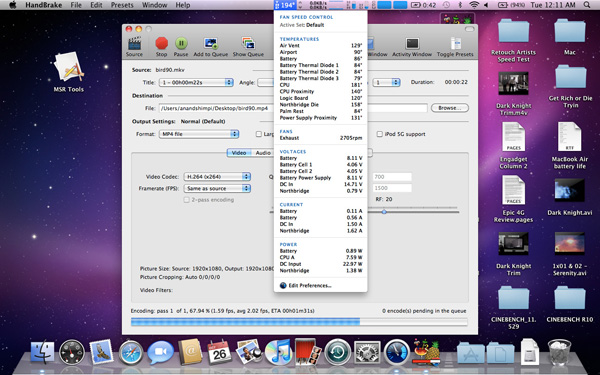
The 2008 MacBook Air under Load
Maximum temperature, at least reported by the MBA’s sensors, isn’t any lower on the new 13-inch than the 2008 I compared it to. Both CPUs hit roughly 84C (183F) under full load. But look at what happens to the chips after a minute at that load:
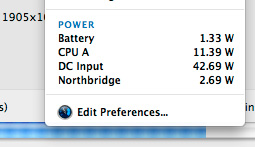 2010 13-inch MacBook Air |
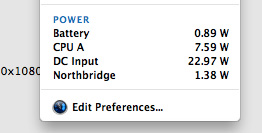 2008 13-inch MacBook Air |
iStat Menus reports the 1.86GHz Core 2 Duo in the 2008 system consuming only 7.59W, while the same CPU in the 2010 machine is drawing 11.45W. The 2008 machine is throttling back to reduce overall temperature while the 2010 system keeps going.
As a result, even the 11-inch MacBook Air will probably end up being as fast, if not faster than the 2nd generation 2008 13-inch MacBook Air. And our performance results confirm that:
| 11-inch MacBook Air (2010) vs. 13-inch MacBook Air (2008) | ||||||||
| Application Launch Test | Adobe Photoshop CS4 | Aperture RAW Import | Cinebench R10 - 1CPU | Cinebench R10 - XCPU | Quicktime H.264 Transcode | |||
| Apple 11-inch MacBook Air (2010) - 1.4GHz Core 2 Duo | 27.8 seconds | 72.4 seconds | 1.29 PPS | 1612 | 2967 | 33.1 fps | ||
| Apple 13-inch MacBook Air (2008) - 1.86GHz Core 2 Duo | 26.4 seconds | 71.3 seconds | 1.20 PPS | 2046 | 2882 | 30.1 fps | ||
You'll notice the less CPU intensive tasks are quicker on the old 13-inch system as the CPU isn't able to get hot enough to trigger Apple's throttling. The single threaded Cinebench test is the best example of this. The 26% performance advantage jibes with the 33% increase in CPU clock speed (it's actually a little low, most likely because the old CPU still isn't running at full speed even in this test). But now look at the heavier tests - the multithreaded Cinebench test and the Quicktime encode. Both of these stress both cores and drive TDP up, which forces Apple to pull clock speed back down. We wondered how Apple was able to cram such a high speed CPU into such a thin chassis as early as it did, now we know.
In practice I found the 2008 13-inch MBA launched applications quicker (short bursts of full clock speed), but after prolonged use or completing CPU intensive tasks it was tough to tell apart from the new 11-inch. What's even more troublesome is that Apple's aggressive clock throttling went relatively undetected until now. This is something I'm going to have to devise tests for and pay more attention to in future reviews. Sneaky, Steve, sneaky.
External Temperatures and Noise
The old MacBook Air chassis had a few dozen slits cut out of the aluminum for ventilation. The new MacBook Air chassis hides the ventilation slits between the base of the unit and the hinge. You can’t see them, but they’re there.
The slits are smaller than they were on the old chassis, which means moving air through them at the same rate sounds louder than before.
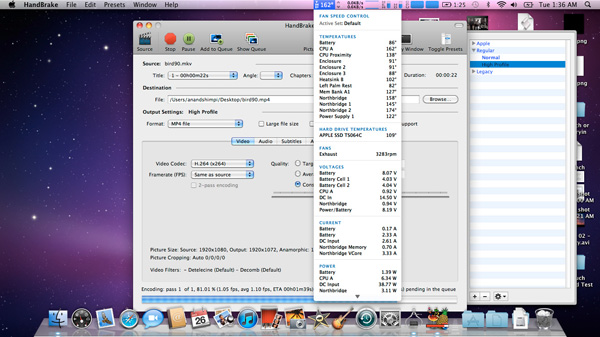
The 11-inch MacBook Air under Load
The CPU in the 11-inch model, even when under heavy loads, likes to stay at or below 72C (162F). At that temperature, the internal fan doesn’t spin above 4000 RPM (usually down below 3400). The 13-inch MacBook Air however is far more likely to generate noise. Running our simple Handbrake test the CPU will peak at over 82C (~180F) and the system’s internal fan will ramp up to over 6K RPM to compensate. Not only does the chassis get hot, but the fan gets audible. It’s still too small of a fan to really be considered loud in the grand scheme of things, but it’s loud enough to be annoying.
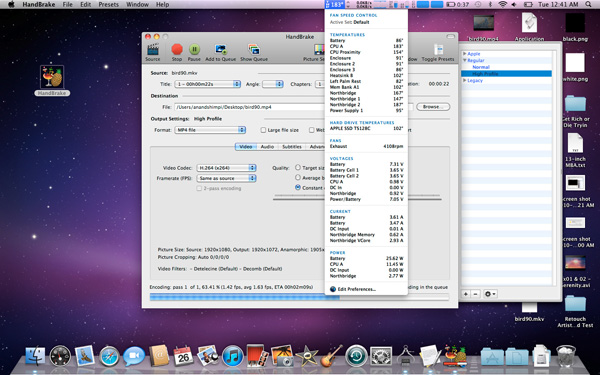
The 13-inch Macbook Air under Load
The surface temperature of the new 13-inch MacBook Air easily gets as high as the 2008 model. I measured a peak of 38.9C (102F) on both the 2008 and 2010 13-inch models. The 11-inch never broke 38C (100F).
Even casual use can ramp up temperatures pretty quickly. Just having a few websites open in the background that use Flash or other CPU intensive elements can slowly cause the MBA’s internal temperatures to rise. And now you’re beginning to see why Apple doesn’t install Flash on these things by default.
The danger zone is the upper left corner of the system, near the hinge. There’s only a single fan that cools both the CPU and GPU in the Air’s very tight enclosure. This is where that fan sits.










185 Comments
View All Comments
khimera2000 - Wednesday, October 27, 2010 - link
but on the flip side many of those larger notebooks make up for graphic loss with a stronger processer, which these will not be able to compete with, not to mention that although it is using a NV320, it is not the discreet model it is the intergrated model which saps your ram just like a netbook not to mention that you can play movies on a netbook. the point of a hard drive is rather mute since you yourself acknowledge that solid state drives exist on netbooks.to assume that netbooks will stay as slow as there oridional releas is kinda off, since technolagy moves at a fast rate. comparing this system to new systems that are released by other companies there is no where that it fits other than as a netbook since your going for the bottom of the barrel for Nvidia cards, and going for a CPU that can be smacked by a I3 mobile theres nothing coming out slower for PC then this unless you look at netbooks.
with this in mind it still just looks like a netbook performance revision.
appliance5000 - Friday, October 29, 2010 - link
So somewhere in this verbiage you're saying it a really really fast and powerful netbook. Ok - if it makes you happy -OK.Demoure - Wednesday, October 27, 2010 - link
Why must it be under 3 pounds? I can't think of a good reason for requiring a laptop under 3 pounds, other than that you are intentionally being picky so as to show it in a better light. At four and a half pounds you have the m11x, a far superior laptop. It is not thin or light, but it is not thick and heavy. Being a scrawny person myself, I cannot think of a person where the 1.5 extra pounds would be a deal breaker.And I do agree with you, it is not a netbook, unlike what the other replier said. It is powerful enough to do what netbooks cannot. As I describe netbooks, they fall short if you try to do anything other than text-based stuff. Ion blurs the lines a little, I've owned an ion laptop before. It was able to play movies flawlessly, but beyond that it was still limited in a netbook way. However, my m11x, and as the performance of the air is not too far off, are quite competent at a variety of things. Just about the only thing I would use my desktop for, but not my m11x, would be the heavy work of encoding, transcoding, that sort of stuff. For everything else, it really does feel like a full fledged laptop, if not a decent desktop. The processor being the limiting factor of the laptop, it is fast enough for everything reasonable.
tno - Wednesday, December 29, 2010 - link
This might sound slight to you but is reasonably significant to me. I'm a paramedic with a transport service based out of a tertiary care center (large hospital). This is very much a transient job, you are either in an ambulance going from one place to the next or in a helicopter doing the same. I like to keep some essentials with me at all times: food, water, phone charger, phone, reading material, lightweight computing option. Now phone goes in a pocket. Water has its own bottle. The rest has to go in my bag.After making do with a bulky laptop bag I decided I needed something slimmer and more useful. So I now have a 20L day pack from North Face. It has a laptop compartment/hydration bladder sleeve, and two water resistant compartments, as well as a few smaller pockets and a rain cover for real wet work. And it ways about 1/4 pound. It's amazing, especially compared to my old two pound bag that was bulky while not actually carrying much more stuff.
Food (two Power bars, a PBJ, an apple and some dried fruit/nuts) is about 1 1/2 lbs. Reading material is about 1/2 lbs. Phone charger's a few ounces. So that's about 2 1/2 lbs, including the bag. A 4 1/2 lbs laptop would bring me up to seven pounds. My Lenovo S10 with a 9 cell battery weighs about 3 lbs and having put both used that and my old Dell 15" lappy (about 4.5 lbs) I was much happier with the S10. One handed transitions from one place to another without having to close the laptop is one maneuver that definitely favors the S10 and one I do a lot.
As much as I'm bumping up all these Mac posts I'm going to start to sound like quite the fan boy. That said I still don't own one. And am having trouble making up my mind on which one to buy. The 13MBA and 13MBP vary by just enough to make the MBP's performance equally as tempting as the MBA's lightness. What a travesty of options.
omega12 - Wednesday, October 27, 2010 - link
Did you just compare the power consumption of an unplugged laptop vs a plugged in laptop? The photo on the left says 0W DC Input and on the right we have 22.97W DC Input. What's up with that?Anand Lal Shimpi - Wednesday, October 27, 2010 - link
Cropped the wrong screenshot, the actual processor power consumption doesn't change when plugged in vs. not in OS X but I ran the test both ways just to be sure.Fixed :)
Take care,
Anand
QChronoD - Wednesday, October 27, 2010 - link
Did you guys test the battery life for the air while running windows? Did I miss it on the charts?I need to replace my old laptop w/ something small so I can carry it all day at school. I don't need lots of power, but most of the software I need to use in lab don't run on OSX (AFAIK).
Anyone know anything else for about $1K that is as thin and light and runs for 4+ hours??
JMS3072 - Wednesday, October 27, 2010 - link
Try the ThinkPad X201.kavanoz - Wednesday, October 27, 2010 - link
You can also check Acer Aspire TimelineX AS1830T-3721. Just make sure to swap out the HDD with a SDD. I put a 40 GB Intel X25-V when I bought it and it just flies. Nowadays a 64 GB Sandforce based SSD makes more sense. You can find them for as low as $120.Demoure - Wednesday, October 27, 2010 - link
Compare it to a netbook and you will be delighted at how speedy and thin it is. Compare it to the ipad and well.. okay so the ipad is a bit silly no matter the comparison. Compare it to asus's UL series, and there you have a decent comparison. Thats one where it could really go either way, based on personal preference and which camp you side with. But when the new air launched, I wondered why a reasonable person would want it over an m11x. It is thinner, certainly.. but, is that really important? No laptop these days is really the thickness of a brick, to judge size, you would think people would be more concerned about length and width. Screen size. How thin the air is.. seems like it would never factor in to any situation. Places where an air can fit, a culv-type laptop would as well. If not for it being thin, I really can't think of a reason to get it over the m11x. Neither are really BAD buys, but the air just seems less impressive in comparison. With the money saved by getting the old r1 (you know, the one with more battery life, cheaper, just as useful, only lacking in its lack of optimus) you could get yourself a fancy ssd, to complete the package. Perhaps I am just baised after finding the m11x to be the perfect little laptop, but despite it being a hideous looking thing, I see no reason to get the air unless you just have to have an apple computer. However if the m11x did not exist, I would not blame anyone for getting an air. It is well rounded.